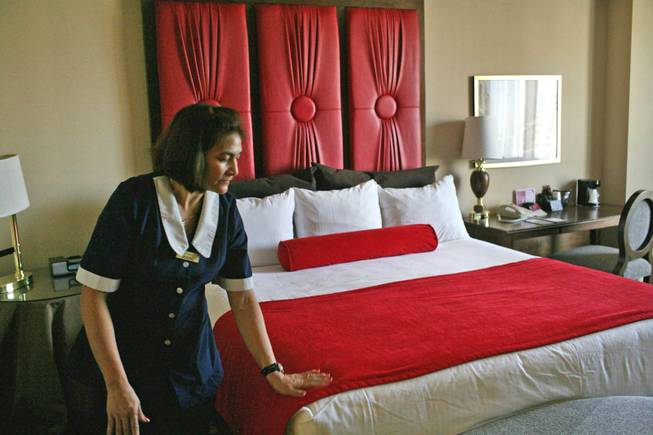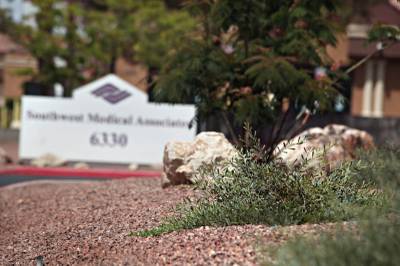
Housekeeper Merita Que straightens a guest room at Paris Las Vegas on Aug. 4, 2009.
Friday, Aug. 7, 2009 | 3 a.m.
For businesses looking to conserve water, it’s the simple things that can make a big difference.
Restaurants offering a glass of water only if requested.
Hotels advising guests that they can hang towels on a rack to be reused rather than receiving fresh ones.
Businesses replacing grass and other water-intensive landscaping with desert plants.
For businesses across the Las Vegas Valley, these and other measures can add up to significant savings.
The Southern Nevada Water Authority offers water conservation and rebate programs geared toward companies.
Currently, 67 business are participating in the program and at any given time, 1 million square feet of grass are being ripped out and replaced with landscaping that uses less water, said Patrick Watson, the authority’s conservation services administrator of business.
“Other than the guy who is maintaining the grass, nobody is using the turf,” he said.
The programs savings add up: Indoors, a business would save $8 for every 1,000 gallons not used. Even better, for every 1,000 gallons of water saved outdoors, a business will save $25.
With electricity and natural gas costs skyrocketing, energy savings efforts get a lot of attention and rightfully so.
But water savings aren’t insignificant, especially during the recession when businesses are looking to trim costs as revenues tumble.
For every square foot of grass removed, a business saves 55 gallons a year, Watson said.
Last year business’ water rates increased 17 percent, he said.
“For businesses, that’s fairly substantial.”
Some Southern Nevada businesses are making serious efforts to cut water use.
UnitedHealthcare is in its final stretch to convert its grass landscaping to xeriscape, said Anne Smith, chief of facilities and administrative services for the Nevada division.
When the water authority offered $1.50 for every square foot of grass replaced with desert landscape last year, she said the company decided the time was prime to replace the turf.
So far it has replaced 59,000 square feet at three of its Southwest Medical Associates buildings and is starting work on its headquarters in the northwest valley.
That project will remove 79,000 square feet of grass, and overall UnitedHealthcare expects to save 5 million gallons of water annually, Smith said.
With the rebate and the money saved from using less water, Smith expects the return on investing in new landscape to take two years.
She described the switch to xeriscape as one of the easiest ways to conserve resources. The other, she said, is changing incandescent light bulbs to compact fluorescent light bulbs that cut energy use by 75 percent.
The company, she added, “has a desire to be a good citizen of the world.”
Depending on the type of business, a company can do several things to cut water use.
The authority’s water-efficiency technologies program provides businesses with a menu to choose from for things such as high-efficiency toilets, shower heads, ice machines or cooling machines. Businesses look through the menu and determine what works for them, Watson said. The authority will verify a business has installed the technology and cuts them a check of up to $50,000.
The authority is open to innovative ways of saving water, too.
If a company has come up with a way to save water that hasn’t yet been evaluated, the authority will monitor the technology for six months, and if it saves water the authority will pay the company an incentive.
There are other ways to save water indoors.
An example of a business that has found ways to conserve water indoors is gaming giant Harrah’s, which has not only has converted turf to xeriscape, but has expanded its water-saving efforts indoors.
Guests are given the option to reuse towels and linens if staying more than one night.
The company relies on its employees to further its environmental strategy, said Gwen Migita, corporate director of social responsibility.
Harrah’s estimates it saves 50 gallons of water a day in each of its 20,300 rooms at its eight Las Vegas properties. The company upgraded its laundry facility to handle 40 percent more volume while saving 72 million gallons of water annually.
At its restaurants, the staff no longer places a glass of water down every time a diner sits down to eat. It also installed a filtration system to bottle its own water in reusable glass bottles for use in its restaurants.
The authority estimates that as much as three gallons of water is saved with every glass of water it doesn’t wastefully deliver. To serve a glass of water, whether or not it’s consumed, requires cleaning the glass, delivery of the water and the water itself.
Harrah’s efforts aren’t limited to indoors.
Over the past four years it has removed about 17 acres of turf at its golf courses and resorts. At its Cascata golf course, 140,000 square feet of turf were removed. At Rio Secco, another golf course, Harrah’s removed 600,000 square feet of grass, saving 23 million gallons annually.
Harrah’s even took the added step of trademarking its efforts, calling it CodeGreen. The initiative also includes its energy reduction efforts and community outreach to promote environmental awareness.
Migita said a company seeking to lower its water use may be best served by forgoing big water-saving projects and focusing on workplace habits that workers will take home with them.
“It’s the small, incremental changes that will bring the greatest change to the community,” she said.



Join the Discussion:
Check this out for a full explanation of our conversion to the LiveFyre commenting system and instructions on how to sign up for an account.
Full comments policy